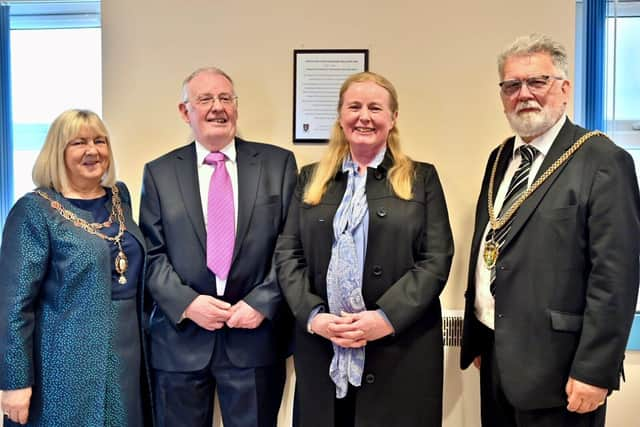Kingsthorpe-born pioneer of medical imaging honoured at Northampton General Hospital
and live on Freeview channel 276
Professor John Rowland Mallard OBE (1927 – 2021) began to develop Magnetic Resonance Imaging technology while working in Aberdeen in the 1960s, resulting in the first whole-body imager service in 1980, now used globally for the detection of diseases such as cancer and dementia.
The Mayor and Mayoress of Northampton were joined by members of the Northampton Hereditary Freemen’s Trustees, Managers from Northampton General Hospital’s Radiology Department and members of Professor Mallard’s family at the hospital’s MRI department on Saturday, 20th April to unveil the plaque, provided by Northampton Town Council.
Advertisement
Hide AdAdvertisement
Hide AdThe Mayor of Northampton, Cllr Stephen Hibbert, said: “Professor Mallard’s ground-breaking work enabled huge advances in medical science and has undoubtedly saved countless lives around the world.


“We are forever proud that such an accomplished individual hailed from Northampton and I’m glad he was honoured with the Freedom of the Town during his lifetime.
“The plaque commemorating Professor Mallard’s many achievements, now located in the MRI department reception at Northampton General Hospital, will ensure that he is further recognised as part of the town’s history.”
The idea of a plaque was first suggested by the Northampton Hereditary Freemen Trustees after Professor Mallard was awarded the Freedom of Northampton in 2018. The trustees worked with Northampton Town Council and Northampton General Hospital to arrange its installation.
Advertisement
Hide AdAdvertisement
Hide AdNGH’s Deputy Supt Radiographer Lisa Whitton said: “MRI scanning has had a major impact on the world of medicine and opened new doors for us in terms of accurate investigation and diagnosis.
“MRI scans image water, which makes them very useful because all tissues of the body contain various amounts of water. This allows high-resolution pictures of many organs and tissues to be taken that are invisible to standard x-rays.
“It means they enable us to detect everything from minor injuries to muscles and joints through to cancers and problems with blood vessels in the brain for conditions like stroke and dementia.
“The impact of this development is still being felt with new and ever more accurate forms of the technology enhancing our ability to recognise and treat a wide range of problems. Professor Mallard’s work has significantly enhanced modern medicine and we are very proud to have his achievements celebrated in our hospital.”
Advertisement
Hide AdAdvertisement
Hide AdBorn in 1927 to a local grocer, Professor Mallard attended Kingsthorpe Grove Junior School and won a scholarship to the Northampton Town and Country School in 1938, going on to study physics at the University College Nottingham and completing his PhD on the magnetic properties of uranium in 1951.
After working as an Assistant Physicist at the Liverpool Radium Institute, he moved to Hammersmith Hospital in 1953, taking up the post of senior physicist in the Royal Postgraduate Medical School of the University of London. He became head of department in 1957 and Reader in 1963, before moving to St Thomas’ Medical School as Reader in 1964.
Much of Professor Mallard’s early ground-breaking work took place in London. He built the first whole-body radio-isotope scanner in 1957, now on display at the London Science Museum, and also developed the first gamma camera.
Professor Mallard retired in 1992 and took up the position of Professor Emeritus of Medical Physics at the University of Aberdeen. He was awarded an OBE in the same year and conferred as an Honorary Freeman of the City of Aberdeen which is given to persons of distinction in 2004. He became a Hereditary Freeman of the Borough of Northampton in October 2018.
Advertisement
Hide AdAdvertisement
Hide AdProfessor Mallard’s son and daughter, John and Katriona, attended the ceremony. They said: “It is so wonderful that Dad’s pioneering work in medical imaging is honoured in Northampton, where he was born and raised.
“This is the perfect place to have Dad’s memorial plaque, outside a busy MRI suite, where patients are helped daily by the scans produced here. That was his ultimate goal and dream.
“Dad said his work would not have been possible without the wonderful support of his family and school teachers in Northampton during his early years and funding from the Northampton Borough Education Department. He was always very grateful.
“Dad was profoundly deaf from an early age, at a time before hearing aids were developed. He managed this so well and it gave him great determination.
Advertisement
Hide AdAdvertisement
Hide Ad“Dad was a truly inspirational man, a creative thinker and determined visionary, but also an unassuming and honourable gentleman.
“He was thrilled to receive the Freedom of Northampton in 2018 and was very proud to be recognised as part of the history of Northampton.
“Thank you so very much to everyone who has been involved in the creation of this plaque.”